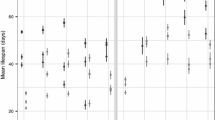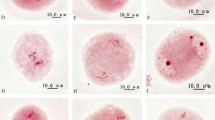Abstract
Oospores produced from matings between US strains ofPhytophthora infestans were subjected to hot or cold temperatures and then evaluated for viability, based on percent germinationin vitro. Of 35 crosses, 3 produced oospores with sufficient germination for replicated assessments of temperature effects. Germination rates were as high as 26%, but the maximum germination percentage varied among crosses. Two additional crosses, one involving isolates from Mexico also had sufficient germination for assessment of temperature effects. Oospores did not germinate after 2 hr treatments at or above 46C, or after 12 hr treatments at 40C. Temperature treatment at -80C suppressed germination. Temperature had a similar effect on oospore germination from all crosses.
Compendio
Se sometieron oósporas producidas por apareamientos entre variantes dePhytophthora infestans de los Estados Unidos a altas y bajas temperaturas y luego se hicieron evaluaciones para analizar su viabilidad, basada en el porcentaje de germinaciónin vitro. De los 35 cruzamientos, 3 produjeron oósporas que germinaron en suficiente cantidad para hacer evaluaciones repetidas de los efectos de la temperatura. Las tasas de germinación alcanzaron hasta un 26%, pero el porcentaje maximo de germinación varié entre los cruzamientos. Dos cruzamientos adicionales, uno involucrando aislamientos provenientes de México, también germinaron en suficiente cantidad para evaluar los efectos de la temperatura. Las oósporas no germinaron después de 2 horas de tratamiento a o encima de 46C, o después de 12 horas de tratamiento a 40C. El tratamiento de la temperatura a -80C suprimió la germinación. La temperatura tuvo un efecto similar en la germinación de las oósporas de todos los cruzamientos.
Similar content being viewed by others
Literature Cited
Caten, C.E. and J.L. Jinks. 1968. Spontaneous variability of single isolates ofPhytophthora infestans. I. Cultural variation. Can J Bot 46: 329–348.
Daggett, S.S., E. Gotz, and C.D. Therrien. 1993. Phenotypic changes in populations ofPhytophthora infestans from Eastern Germany. Phytopathology 83: 319–323.
Bruyn, H.L.G. 1926. The overwinteringof Phytophthora infestans (Mont.) de Bary. Phytopathology 16: 121–140.
Drenth, A., E.M. Janssen, and F. Govers. 1995. Formation and survival of oospores ofPhytophthora infestans under natural conditions. Plant Pathol 44: 86–94.
Gallegly, M.E. and J. Galindo. 1958. Mating types and oospores ofPhytophthora infestans in nature in Mexico. Phytopathology 48: 274–277.
Goodwin, S.B., B.A. Cohen, and W.E. Fry. 1994. Panglobal distribution of a single clonal lineage of the Irish potato famine fungus. Proc Natl Acad Sci 91: 11591–11595.
Goodwin, S.B., L.J. Spielman, J.M. Matuszak, S.N. Bergeron, and W.E. Fry. 1992. Clonal diversity and genetic differentiation ofP. infestans populations in Northern and Central Mexico. Phytopathology 82: 955–961.
Goodwin, S.B., L.S. Sujkowski, A.T. Dyer, B.A. Fry, and W.E. Fry. 1995. Direct detection of gene flow and probable sexual reproduction ofPhytophthora infestans in Northern North America. Phytopathology 85: 473–479.
Juarez-Palacios, C., R. Felix-Gastelum, R.J. Wakeman, E.J. Paplomatas, and J.E. DeVay. 1991. Thermal sensitivity of three species ofPhytophthora and the effect of soil solarization on their survival. Plant Dis 75: 1160–1164.
Mosa, A.A., K. Kobayashi, A. Ogoshi, M. Kato, and N. Sato. 1993. Isoenzyme polymorphism and segregation in isolates ofPhytophthora infestans from Japan. Plant Pathol 42: 26–34.
Neter, J., W. Wasserman, and M.H. Kutner. 1990. Applied Linear Statistical Methods. Irwin, Boston, M.A. Chapter 9: Polynomial Regression.
Perches, E.S. and A.J. Galindo. 1969. Supervivencia delPhytophthora infestans (Mont.) de Bary del Tizón tardio de la papa y jitomate. Agrociencia 5: 92–98.
Pittis, J.E. and R.C. Shattock. 1994. Viability, germination and infection potential of oospores ofPhytophthora infestans. Plant Pathol 43: 387–396.
Ribeiro, O.K. 1983. Physiology of asexual sporulation and spore germination inPhytophthora.In: Erwin, D.C., S. Bartnicki-Garcia, and P.H. Tsao, eds. Phytophthora, its Biology, Taxonomy, Ecology and Pathology. APS Press, St Paul, MN. 55–70 pp.
Shattock, R.C., P.W. Tooley, and W.E. Fry. 1986. Genetics ofPhytophthora infestans. Determination of recombination, segregation, and selfing by isozyme analysis. Phytopathology 76: 410–413.
Spielman, L.J., B.J. McMaster, and W.E. Fry. 1989. Dominance and recessiveness at loci for virulence against potato and tomato inPhytophthora infestans. Theor Appl Genet 77: 832–838.
Author information
Authors and Affiliations
Rights and permissions
About this article
Cite this article
Fay, J.C., Fry, W.E. Effects of hot and cold temperatures on the survival of oospores produced by United States strains ofPhytophthora infestans . American Potato Journal 74, 315–323 (1997). https://doi.org/10.1007/BF02851575
Accepted:
Issue Date:
DOI: https://doi.org/10.1007/BF02851575




